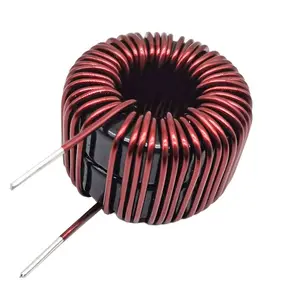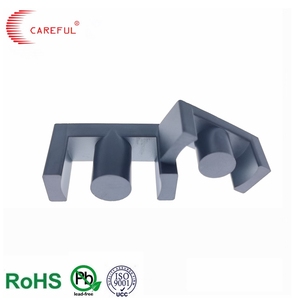
All categories
Featured selections
Trade Assurance
Buyer Central
Help Center
Get the app
Become a supplier

(1447 products available)
































The realm of passive components in the electronics industry includes a critical component known as ferrite toroid iron powder core . These components are essential in managing electromagnetic interference in various electronic devices, ensuring optimal performance and longevity. Found in a variety of shapes and sizes, ferrite toroid iron powder core are integral in numerous applications, from consumer electronics to industrial equipment. Their unique properties enable them to absorb high-frequency noise and suppress electromagnetic interference, making them indispensable in modern technology. As technology advances, the demand for efficient ferrite toroid iron powder core continues to grow, driven by the need for reliable and efficient electronic devices.
There are several types of ferrite toroid iron powder core available on the market, each serving different purposes depending on their composition and application. The most common types include soft ferrites and hard ferrites. Soft ferrites, typically made of iron oxide combined with nickel, zinc, or manganese compounds, are known for their high magnetic permeability and low electrical conductivity. These characteristics make them ideal for use in transformers, inductors, and antennas. On the other hand, hard ferrites, often composed of strontium or barium compounds, are used in permanent magnets due to their ability to maintain a strong magnetic field. Each type of ferrite toroid iron powder core is engineered to meet specific requirements, ensuring optimal performance in its respective application.
The primary function of ferrite toroid iron powder core is to minimize electromagnetic interference (EMI) and radio frequency interference (RFI) in electronic circuits. This is achieved through their ability to absorb high-frequency noise and convert it into heat, which is then dissipated. ferrite toroid iron powder core are typically utilized in power supplies, communication devices, and audio-visual equipment, where they help maintain signal integrity and prevent unwanted noise interference. Their features include high saturation magnetization, low coercivity, and excellent frequency response, making them suitable for high-frequency applications. Additionally, the compact size and lightweight nature of ferrite toroid iron powder core allow for easy integration into various electronic devices, enhancing their overall efficiency and performance.
ferrite toroid iron powder core are composed of a combination of metal oxides, primarily iron oxide, and other metallic elements such as manganese, zinc, nickel, strontium, or barium. The specific composition of a ferrite toroid iron powder core determines its magnetic properties and suitability for different applications. For instance, manganese-zinc ferrites are preferred in applications requiring high permeability and low core losses, while nickel-zinc ferrites are ideal for high-frequency applications due to their higher resistivity. The manufacturing process involves mixing the raw materials, pressing them into the desired shape, and then sintering them at high temperatures to form a solid, dense body. This process ensures that ferrite toroid iron powder core possess the necessary magnetic and electrical properties for their intended use.
Incorporating ferrite toroid iron powder core into electronic devices requires careful consideration of the device's specific requirements and operating conditions. To effectively use ferrite toroid iron powder core , it is crucial to select the appropriate type based on the frequency range and power levels of the application. Proper placement within the circuit is also essential to maximize their effectiveness in reducing electromagnetic interference. In power supply circuits, ferrite toroid iron powder core can be used as cores for inductors or transformers to improve efficiency and reduce noise. In communication devices, they can be used in the form of beads or cores to suppress high-frequency noise on signal lines. Regular maintenance and inspection of ferrite toroid iron powder core are necessary to ensure their optimal performance, as any damage or degradation can affect their ability to suppress EMI effectively.
When choosing ferrite toroid iron powder core for your electronic applications, several factors must be taken into account to ensure optimal performance. The frequency range of your device plays a crucial role in determining the type of ferrite toroid iron powder core you should select. High-frequency applications typically require nickel-zinc ferrites due to their higher resistivity, whereas manganese-zinc ferrites are better suited for low-frequency applications where high permeability is needed. Additionally, the operating temperature and environmental conditions can impact the performance of ferrite toroid iron powder core , making it essential to select materials that can withstand specific conditions without degradation.
Another significant factor is the physical dimensions and shape of the ferrite toroid iron powder core . Depending on the circuit design, you may require specific geometries such as toroidal, cylindrical, or rectangular shapes to fit the space constraints and enhance the magnetic coupling efficiency. It is also important to consider the electrical characteristics, such as inductance and impedance, to ensure compatibility with the device's requirements. The choice of ferrite toroid iron powder core should align with the intended use to prevent any adverse effects on the device's performance and longevity.
ferrite toroid iron powder core offer several advantages in electronic devices, including their ability to effectively suppress electromagnetic interference and maintain signal integrity. Their high magnetic permeability and low electrical conductivity make them ideal for applications such as transformers and inductors, where they help improve efficiency and reduce noise. Additionally, the compact size and lightweight nature of ferrite toroid iron powder core facilitate easy integration into various electronic circuits.
To determine the appropriate type of ferrite toroid iron powder core for your application, consider the frequency range and power levels of your device. Nickel-zinc ferrites are suitable for high-frequency applications due to their higher resistivity, while manganese-zinc ferrites are preferred for low-frequency applications requiring high permeability. It's also important to assess the environmental conditions and operating temperature to choose materials that can withstand specific conditions without degradation.
ferrite toroid iron powder core are commonly used in a variety of electronic applications, including power supplies, communication devices, and audio-visual equipment. They are utilized in transformers and inductors to improve efficiency and reduce noise, as well as in signal lines to suppress high-frequency noise. Their ability to absorb high-frequency noise and convert it into heat makes them indispensable in maintaining signal integrity and preventing unwanted interference.
Yes, ferrite toroid iron powder core can be customized to meet the specific requirements of electronic devices. Manufacturers can tailor the composition and shape of ferrite toroid iron powder core to enhance magnetic coupling efficiency and fit space constraints. Customization allows for optimized performance and compatibility with the device's electrical characteristics, ensuring that the ferrite toroid iron powder core effectively suppresses electromagnetic interference and maintains signal integrity.
Regular maintenance of ferrite toroid iron powder core in electronic devices is crucial to ensure their optimal performance. This includes inspecting for any damage or degradation that may affect their ability to suppress electromagnetic interference effectively. Cleaning and ensuring proper placement within the circuit are essential to maintain the integrity of ferrite toroid iron powder core . Periodic testing and evaluation can help identify any issues early and prevent potential performance disruptions.